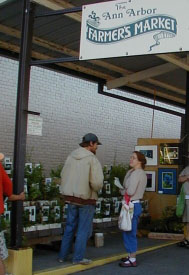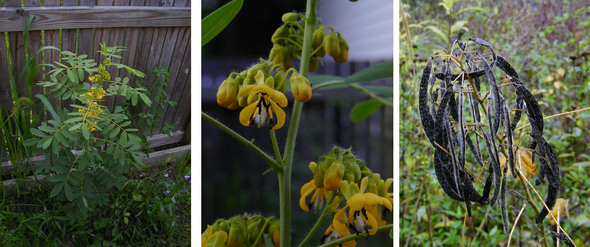Getting to know your native plant suppliers: Greg Vaclavek, a native nurseryman

Greg Vaclavek, educating the public about native plants at the Ann Arbor Farmers' Market
Photo by Mark Charles
A few entries ago, we learned about Bill Schneider, owner of Wildtype Nursery in Mason, Mich.
Today, we turn our pseudo-microphone to Greg Vaclavek, owner of Native Plant Nursery, which is based here in Ann Arbor.
Even if you haven’t delved into the world of native plants even a little bit, there is a good chance you’ve seen Greg at the Ann Arbor Farmer’s Market, as he’s been a fixture there since 1998. He is most often seen engaged in a conversation with a customer, and if you listen in, you’re sure to learn a lot. Let’s learn something about him.
Greg grew up in the bustling metropolis of Garden City, just west of Detroit, when there were still some open lots, a few woodlots remaining, and even a dirt road or two. He enrolled in the University of Michigan where he engaged in the buffet style of school, sampling a number of programs before finally settling into the School of Natural Resources. There, he earned a bachelor’s degree, and made friends and contacts that would eventually lead to a successful native plant business.
Immediately upon graduating, he got a summer position working with a graduate student, cataloguing riverine ecosystems along rivers in Michigan’s Huron and Manistee National Forests.
The research group drew transects (straight lines with sampling plots along them) extending from the river’s edge up to the uplands, crossing river banks, levees, floodplains and upper banks. They sampled hundreds of plots, counting and identifying trees, shrubs and herbaceous plants within the plots.
Greg had learned a great deal about woody plants through his Woody Plants and Forest Ecology classes at Michigan. However, none of the group had an encyclopedic knowledge of the herbaceous plants they were encountering, so late nights were spent learning the plants, keying them out, or preserving the plants they couldn’t identify for later identification by plant experts like Tony Reznicek and Ed Voss. This experience gave him a solid background in learning the plants and their preferred habitats that would serve him well in his current business.
A year after this experience, he ran into his friend Bill Schneider (remember him?) who was working with Ann Arbor’s Natural Areas Preservation program (NAP) and suggested that he join up as a full-time worker. This work included gathering and processing native plant seed from local areas for use in future NAP conservation efforts.
Greg tried planting small amounts of this seed in areas around his rental unit and got a thrill from participating in the entire process of seeing the plants in the wild, collecting and processing the seed, and growing the seed into the same plants he had collected them from.
Conversations with Bill and his success in growing the plants planted the seed (yes, I said it) to start a native plant nursery himself, and, in 1998, he and friend Mike Appel started growing approximately 15 species of plants and selling them at the Ann Arbor’s Farmer’s Market.
Greg was a member of the Ann Arbor Wild Ones chapter from the beginning, and they were among his earliest customers. Talking with native plant enthusiasts and people who know nothing about them is another thing that gives Greg a big thrill and, as anyone who has talked with him or witnessed him in action, he is extremely good at it, passing on a load of information about native plants, where they’re found in nature, and where they can do well in an individual’s personal landscape.

Some photos of one of Greg's favorite plants, Wild Senna (Cassia hebecarpa). From left, the plant in bloom, a flower closeup and the mature seed pods
Photos by Greg Vaclavek, Native Plant Nursery
Thirteen years later, Greg has expanded his plant list to approximately 160 species and also consults with people on their landscapes. This experience has given him a lot of insight into people’s perceptions of and use of native plants.
He has observed that many people, when they think of using native plants in their yards, think that that will involve no maintenance, that native plants are a sort of panacea for weeds and will lead to a carefree landscape. Also, when people plant native seed mixes, they may think that they will end up with a beautiful patchwork of blooms by the end of the first growing season.
Unfortunately, neither of these is true, nor is the expectation that a carefully planned design of native plants will stay in perfect order over time without work. For one thing, weeds come into a landscape, native or not.
Secondly, seeds of perennials generally take a good year or two to become established before they produce lots of beautiful flowers, and seed mixes don’t generate patchworks — they create a more random pattern. Over time, a quasi-patchwork may develop in spots as the plants adapt to the soil, light and moisture conditions of the site, but nothing you can plan on (and rarely a monoculture look popular in magazine landscapes).
Third, seeding plants may drift into other areas, even into areas where you don’t want them. Work (i.e. maintenance and, gasp, weeding) is required to keep even a native plant landscape looking good. Through proper plant selection based on consideration of your existing conditions and proper site preparation, you may be able to reduce the amount of maintenance work you’ll have to do, but don’t expect that you’ll have to do nothing.
Greg’s wealth of field experience has made it difficult for him to settle on a favorite native plant, but he does lean toward common or widespread species. Among these are White vervain (Verbena urticifolia) and White avens (Geum canadense).
A more exotic native that he enjoys is Wild Senna (Cassia hebecarpa). This plant is naturally found in wetlands and wetland edges, and may reach heights of four to six feet. As a member of the pea family, it has compound leaves and yellow flower clusters throughout the upper reaches of the plant that eventually become long , shiny black seed pods. The leaves turn orange in the fall so the plant takes on a nice Halloween color scheme, fun for the entire family.
Boneset (Eupatorium perfoliatum) is another favorite for its attraction to a huge number of pollinators.
If you have a strong interest, or even a passing interest, in native plants, take a look at his excellent website (www.nativeplant.com) or pay him a visit at the Farmer’s Market at his usual spot along Fourth Avenue on Saturday mornings.
You are bound to learn something when you talk with Greg, and will have a pleasant time talking with him. And, I would be surprised if you don’t find room in your personal landscape for at least one of the beautiful and interesting plants he offers.
Spring is passing and summer is coming, and as a result the mix of plants blooming in my yard is also changing. Currently in bloom are Wild geranium and Golden Alexander (which look great together, I might add), Virginia waterleaf, Common cinquefoil, Yellow pimpernel, Graceful sedge, Horse gentian/wild coffee, Solomon’s Seal, False Solomon’s Seal and a native rose I can't identfy (I think it's Rosa carolina). Get out and enjoy nature everyone (and take your bug repellant)!
Rick is a local landscape architect with a special interest in all things natural, including native plants and the critters that eat them. You can contact him at yourland1824@gmail.com.

